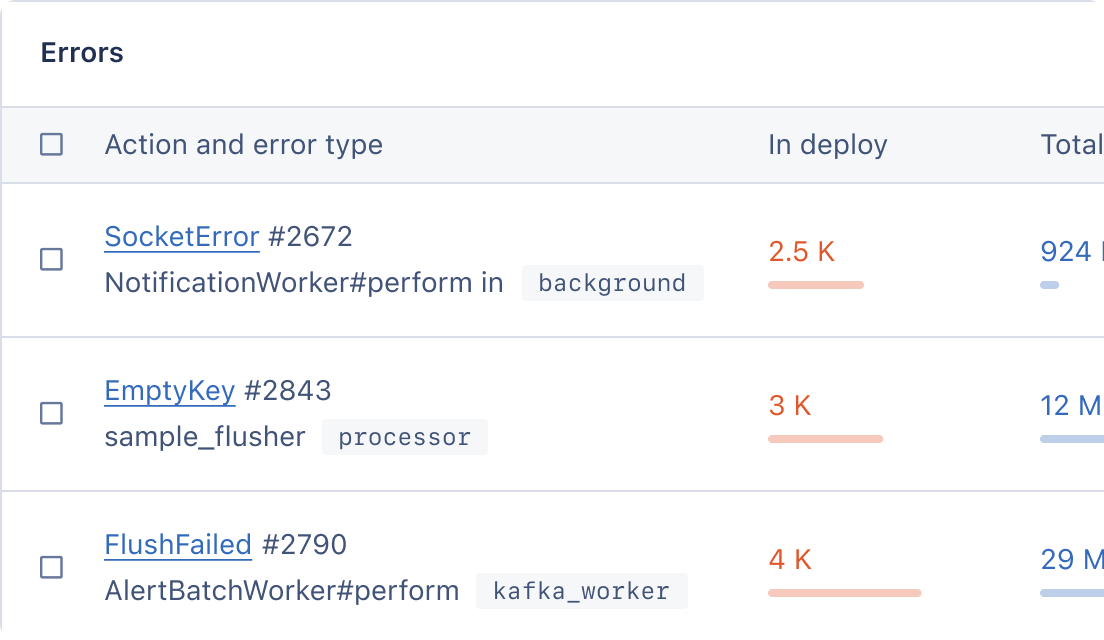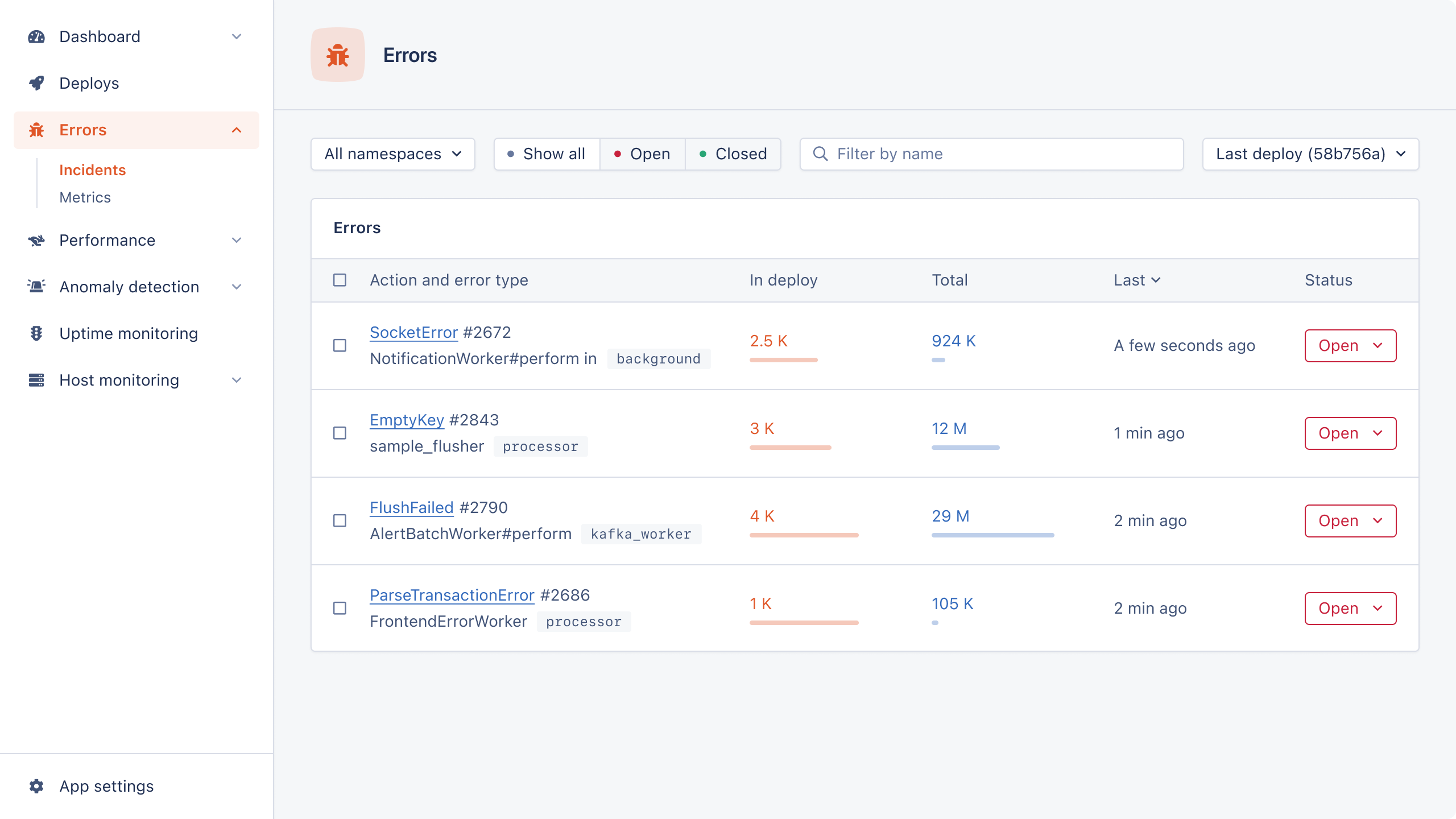
Having previously compared the top 5 Datadog alternatives, we're now going to compare Honeybadger with its top competitors to help you find the best alternative.
Let's start by first comparing Honeybadger to AppSignal.
1. AppSignal
AppSignal is an application performance monitoring tool that makes it easy for diverse teams of developers to monitor their applications.
At AppSignal, we're proud to have simple, straightforward pricing and a relaxed upgrade policy. Our billing model is fair, predictable, and scalable, with all our monitoring features available on all plans. With AppSignal, you will always know what you're paying for.
- Founded: 2012
- Supports: Ruby, Elixir, Node.js, Front-end Javascript, Python
- G2 Rating: 4.8/5
- Plans start from: $23 per month

AppSignal's Features: A Breakdown
- Error Tracking: Be notified when errors occur and track them easily across deployments.
- Performance Monitoring: Pin-point the underperforming functions and requests that impact your app the most.
- Host Monitoring: Keep your hardware in check with live data on disk usage, network usage, CPU, and more.
- Anomaly Detection: Set up triggers that alert you to abnormal behavior, such as error rate spikes, high memory usage, or slow response times.
- Check-ins: Monitor cron jobs, background jobs, continuous processes, and more.
- Uptime Monitoring: Receive alerts when your application experiences downtime with minutely pings.
- Metric Dashboards: Track your app metrics visually with AppSignal's custom dashboards. Dashboards are automatically created in AppSignal for popular integrations like PostgreSQL or Sidekiq.
- Log Management: Effortlessly manage your logs in a single interface and navigate from a log line to an error report, performance sample, and more.
- Simple Pricing: Thanks to our simple overage-free pricing, you won't get unexpectedly high bills with AppSignal.
Why Developers Monitor with AppSignal
Companies, from startups to SMEs and beyond, appreciate AppSignal's ability to make monitoring simple. Our comprehensive plans, transparent pricing, and flexible upgrade policy mean our customers don't experience bill shock; switching to a plan that fits your needs is easy.
With AppSignal's business add-ons, customers don't need to opt for expensive enterprise plans. They can sign a Business Associate Agreement (BAA) or arrange long-term log storage at the click of a button.
It provides all the important tools needed for monitoring our application. It's really simple to implement. With AppSignal, we are able to easily diagnose any potential issues with our application and keep it running without any problems. They keep improving their services, and their customer support is fantastic.
What Developers Say About AppSignal
Reviewers on G2 give AppSignal 4.8/5 stars. If you're considering switching from Honeybadger to AppSignal, we'd recommend taking the following customer feedback into account.
Pros
- Clear Affordable Pricing: AppSignal's pricing is transparent, meaning it's always easy to understand costs and avoid overage fees.
- Ease of Use: Customers love AppSignal's interface and quick setup, which means you can start monitoring your app in minutes.
- Out-of-the-Box Support: AppSignal's integrations are packed with out-of-the-box functionality, helping developers monitor core metrics without complex instrumentations.
Cons
- Limited Language Support: AppSignal supports Ruby, Elixir, Node.js, Python, and front-end JavaScript applications, with limited support for Go, while Honeybadger also offers support for Crystal and PHP.
- No Freemium Tier: Honeybadger offers a limited freemium tier. While AppSignal has no free plan, its paid-for plans are cheaper than Honeybadger's.
- No Query Interface: Honeybadger allows you to query your metrics for insights with BadgerQL. AppSignal relies instead on traditional search and filter-based querying methods, but does offer GraphQL support for more complex query needs.
Honeybadger vs. AppSignal
Let's see how Honeybadger's and AppSignal's features and functionality compare:
| Feature | Honeybadger | AppSignal |
|---|---|---|
| Error tracking | ✓ | ✓ |
| Performance monitoring | ✓ | ✓ |
| Host monitoring | ⨉ | ✓ |
| Uptime monitoring | ✓ | ✓ |
| Automated dashboards | ✓ | ✓ |
| Background job and process monitoring | ✓ | ✓ Monitor cron jobs, background processes, and more with check-ins. |
| Namespace monitoring | ⨉ | ✓ |
| Custom metrics | ✓ | ✓ |
| Unlimited free customers | ✓ | ✓ |
| Free 30-day trial | ✓ | ✓ |
| Free support | ✓ | ✓ |
| Relaxed upgrades and simple pricing | ⚠️ Simpler pricing but will charge for overages | ✓ |
2. Sentry
- Founded: 2008
- Supports: 22+ libraries and frameworks, including, Ruby, Elixir, Python, and Go.
- G2 Rating: 4.5/5
- Plans start from: $26 per month

Sentry's Features: A Breakdown
- Broad Software Support: Sentry supports dozens of programming languages, making it ideal for teams monitoring multiple tech stacks.
- Efficient Error Tracking: Helping developers swiftly resolve application errors.
- Comprehensive Performance Monitoring: Provides detailed application performance insights.
- Session Replay Feature: You can record and replay user sessions to better understand the root causes of errors.
Why Developers Monitor with Sentry
With its large library of supported languages, Sentry is perfect for teams with a diverse stack:
Sentry is one of the most useful tools we used for error detection and monitoring. It's very easy to integrate in our project, and helps us to identify edge cases and bugs when they happen.
What Developers Say About Sentry
On G2, Sentry has a score of 4.5/5 stars. Customers considering switching to Sentry should first weigh up some key pros and cons from customer reviews.
Pros
- Broad Language Support: Sentry supports more than 20 programming languages.
- Detailed Error Reporting: Provides clear and thorough error reports for efficient troubleshooting.
- Mobile App Monitoring: Makes it possible to monitor mobile apps, for cross-platform coverage.
Cons
- Strict Error Limits: Customers may quickly reach their plan limit when a recurring bug occurs, potentially drowning out more urgent issues.
- Limited Features: A business plan is needed to use all of Sentry's features, making it a more expensive monitoring option than some of its competitors.
- Steep Learning Curve: Due to some of Sentry's more complex features and implementations, migrating customers might find it difficult to fully leverage its functionality.
Honeybadger vs. Sentry
Now you've got a better idea of why customers use Sentry, let's compare its features and functionality to Honeybadger:
| Feature | Honeybadger | Sentry |
|---|---|---|
| Error tracking | ✓ | ✓ |
| Performance monitoring | ✓ | ✓ |
| Host monitoring | ⨉ | ✓ |
| Uptime monitoring | ✓ | ✓ |
| Automated dashboards | ✓ | ⚠️ You need to provide your stack to Sentry for accurate suggestions |
| Background job and process monitoring | ✓ | ✓ |
| Namespace monitoring | ⨉ | ⨉ |
| Custom metrics | ✓ | ✓ |
| Unlimited free customers | ✓ | ✓ (But excluded on free plans) |
| Free 30-day trial | ✓ | ⨉ 14 days |
| Free support | ✓ | ⨉ |
| Relaxed upgrades and simple pricing | ✓ | ⨉ |
3. New Relic
- Founded: 2007
- Supports: Ruby, Python, Go, Node.js, PHP, .NET, Java
- G2 Rating: 4.3/5
- Plans start from: Depends on usage, e.g., 100 GB of free data ingested per month, $0.35/GB ingested beyond.

New Relic Features: A Breakdown
- Session Replay: Replay sessions to gain insights into end-user interactions.
- Web Performance Monitoring: Improve SEO and measure your web page's performance.
- SAP Monitoring: Provides SAP integration support.
- Cloud Monitoring: New Relic offers support for Azure, Google Cloud, and AWS.
Why Developers Monitor with New Relic
New Relic is a great solution for hobbyists who want to take advantage of their limited freemium tier, or large enterprises with complex cloud infrastructures to monitor. Due to their high pricing, New Relic may not be the most cost-friendly solution for startups, scaleups, and SMEs.
New Relic customers find it easy to navigate:
Everything is in one place. The APM is exceptionally good and you can find n+1's so easily. Also you can just [go] right into problematic lines.
What Developers Say About New Relic
On G2, New Relic scores 4.3/5 stars. If you're considering switching from Honeybadger to New Relic, it's important to weigh up the following pros and cons.
Pros
- Freemium Tier: With its free monitoring tier, New Relic customers enjoy limited monitoring capabilities at no initial cost.
- Simple Setup: Customers often praise New Relic's simple setup process and onboarding experience.
- SAP Support: New Relic seamlessly integrates with SAP, offering comprehensive monitoring solutions for enterprise clients.
Cons
- User-Based Pricing: New Relic charges per user, making it more expensive for larger teams.
- Information Overload: The volume of data collected by New Relic can sometimes overwhelm customers, making it difficult to pinpoint and prioritize key insights.
- Poor Documentation: Customers report that New Relic's documents are sometimes outdated and hard to navigate, potentially slowing down or stalling the onboarding process.
Honeybadger vs. New Relic
Having looked more closely at New Relic, let's compare its features with Honeybadger:
| Feature | Honeybadger | New Relic |
|---|---|---|
| Error tracking | ✓ | ✓ |
| Performance monitoring | ✓ | ✓ |
| Host monitoring | ⨉ | ⨉ |
| Uptime monitoring | ✓ | ⨉ |
| Automated dashboards | ✓ | ✓ |
| Background job and process monitoring | ✓ | ⨉ |
| Namespace monitoring | ⨉ | ⨉ |
| Custom metrics | ✓ | ✓ |
| Unlimited free customers | ✓ | ⨉ |
| Free 30-day trial | ✓ | ⨉ 14 days |
| Free support | ✓ | ⨉ |
| Relaxed upgrades and simple pricing | ⚠️ Simpler pricing but will charge for overages | ⨉ |
4. Datadog
- Founded: 2010
- Supports: 26+ libraries and frameworks, including Ruby, Elixir, Python, and Go.
- G2 Rating: 4.3/5
- Plans start from: $15 per month

Datadog's Features: A Breakdown
- Broad Software Support: Datadog is well suited for teams with language-agnostic stacks, supporting 26 programming languages.
- Sandbox Environment: Datadog functions as an APM and observability sandbox, allowing advanced customers to customize it to fit specific needs.
- Extensive Feature Set: Datadog offers a wide range of features, including the ability to detect vulnerabilities in your libraries.
Why Do Developers Use Datadog?
Datadog offers a comprehensive range of monitoring features, making it especially well-suited for larger organizations with complex needs. It focuses on providing a centralized view of a product with a heavy focus on reporting and analytics.
I like its enormous portfolio of integrations and services. It's really easy to use and we integrate it in both our mobile and web-based applications. We mainly use it daily to track metrics and even reports from customers.
What Developers Say About Datadog
Datadog scores 4.3/5 on G2. Customers wanting to switch to Datadog from Honeybadger may want to consider the following pros and cons.
Pros
- Broad Software Support: Datadog is well-suited for teams using language-agnostic solutions, supporting 26 programming languages.
- Sandbox UI: Datadog functions as an APM tool and observability sandbox, allowing customization to fit specific needs.
- Comprehensive Features: Datadog provides a wide range of features, including the ability to detect vulnerabilities in your libraries.
Cons
- Complex Pricing: With over 75 plans, customers often find it challenging to understand their billing, leading to potentially unpredictable costs and confusing invoices.
- Data-Centric Approach: Datadog's focus on metric data reporting can be overwhelming or frustrating for customers who prefer a more straightforward solution-oriented monitoring tool.
- Steep Learning Curve: New customers might find it difficult to fully leverage Datadog's features due to its complex user interface and sandbox-style monitoring approach.
Honeybadger vs. Datadog
Let's compare Datadog head-on with Honeybadger:
| Feature | Honeybadger | Datadog |
|---|---|---|
| Error tracking | ✓ | ✓ |
| Performance monitoring | ✓ | ✓ |
| Host monitoring | ⨉ | ✓ |
| Uptime monitoring | ✓ | ⚠️ Only with Synthetic Monitoring plan |
| Automated dashboards | ✓ | ⨉ |
| Background job and process monitoring | ✓ | ✓ |
| Namespace monitoring | ⨉ | ⨉ |
| Custom metrics | ✓ | ⚠️ Limited based on plan |
| Unlimited free customers | ✓ | ✓ |
| Free 30-day trial | ✓ | ⨉ 14 days |
| Free support | ✓ | ⨉ |
| Relaxed upgrades and simple pricing | ⚠️ Simpler pricing but will charge for overages | ⨉ |
5. Scout
- Founded: 2008
- Supports: Ruby, Python, Elixir, PHP
- G2 Rating: 4.6/5
- Plans start from: $19 per month

Scout's Features: A Breakdown
- Code Backtraces: Scout can identify issues directly within your code with its GitHub integration.
- OpenTelemetry Agent: Scout's OpenTelemetry agent supports monitoring OpenTelemetry traces, logs, and metrics.
- Time Comparisons: You can compare current metrics against historical averages to view current and past performance trends.
Why Do Developers Monitor with Scout?
With its cost-effective plans and strong focus on performance insights, Scout is a great choice for teams that track errors with Rollbar.
Customers like Scout's usability and say that it's easy to find and fix problems.
Easy to set up, easy to use. Nice email updates about performance changes day-to-day. Integrates into local apps as well, helping avoid deployment of performance issues. And a great support team!
What Developers Say About Scout
On G2, reviewers rate Scout 4.6/5 stars. This is what Scout customers like and dislike about the service:
Pros
- Easy Setup: Customers value Scout APM's simple setup process.
- Deep Database Insights: With in-depth database performance insights, Scout can help customers identify and resolve potential bottlenecks.
- Responsive Customer Support: Customers frequently praise Scout for its great support, with their questions often quickly answered.
Cons
- Rollbar Dependence: Due to its Rollbar error tracking dependency, Scout requires customers to integrate and pay for an additional tool rather than offering a unified solution.
- Restricted Filtering Options: Some customers find Scout's filtering capabilities limited and lacking in customization, making data navigation and analysis more challenging.
- Limited Third-Party Integrations: Customers noted Scout offers support for fewer third-party integrations (it doesn't offer support for platforms like Discord, GitLab, and Jira), which can complicate integration into existing workflows.
Honeybadger vs. Scout
Let's see how Scout directly compares to Honeybadger:
| Feature | Honeybadger | Scout |
|---|---|---|
| Error tracking | ✓ | ⚠️ Yes, with a Rollbar integration |
| Performance monitoring | ✓ | ✓ |
| Host monitoring | ⨉ | ⨉ |
| Uptime monitoring | ✓ | ⨉ |
| Automated dashboards | ✓ | ⨉ |
| Background job and process monitoring | ✓ | ⨉ |
| Namespace monitoring | ⨉ | ⨉ |
| Custom metrics | ✓ | ⚠️ Yes, via custom contexts |
| Unlimited free customers | ✓ | ✓ |
| Free 30-day trial | ✓ | ⨉ 14 days |
| Free support | ✓ | ✓ |
| Relaxed upgrades and simple pricing | ⚠️ Simpler pricing but will charge for overages | ✓ |
Choosing the Application Performing Monitoring Tool That Best Matches Your Needs
Now that you've explored five alternatives to Honeybadger, you might be wondering how to determine which one best fits your needs. Here are some key factors to consider:
- Feature Set: Which alternative offers the features you need to monitor your app?
- Pricing: Which option fits your budget, considering current and potential future costs?
- Usability: Which alternative provides a level of usability that you and your team are comfortable with?
- Integrations: Which option integrates best into your existing workflow? Are there critical third-party integrations you rely on that must be supported?
- Documentation: Which alternative has the documentation needed for a successful implementation? Does it offer solutions for the monitoring scenarios that are crucial for you?
All Honeybadger alternatives have pros, cons, and caveats: no one solution is perfect. What works well for other teams might not be a good fit for your own. We recommend trialling several options to find the tool best suited to your core monitoring requirements.
Why We Think AppSignal is a Great Honeybadger Alternative
This is why we believe AppSignal is the best fit alternative for Honeybadger customers:
- Relaxed Upgrades and Simple Pricing: AppSignal's request-based pricing is straightforward and flexible, potentially offering more value than a comparable Honeybadger plan. Thanks to our flexible upgrade policy, there are no surprise overage fees; only predictable monthly costs.
- Built By Developers, For Developers: AppSignal has the tools every team needs to monitor, manage, and scale applications efficiently.
- Clear, Actionable Insights: AppSignal focuses on delivering critical insights and avoids overwhelming you with data or complicated setups.
We know switching APMs can be challenging, which is why AppSignal offers a 30-day free trial so you can see how it works for your team. You can sign up for a free trial without providing any credit card information.
If you need help switching to AppSignal or have any monitoring questions, please contact us at any time!


